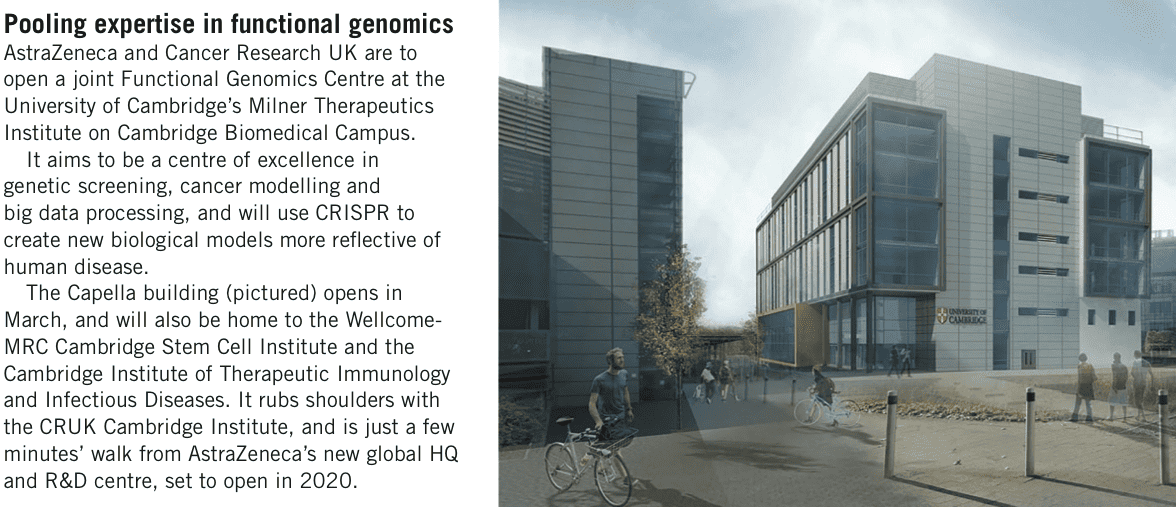Gene editing as a therapeutic tool has ignited an explosion of excitement within the industry over the past few years: the science fiction concept of being able to simply remove and replace a faulty, disease-causing gene is now becoming a reality.
With an array of such tools in play, scientists seem to be on the cusp of a revolution – but one gene-editing approach is delivering on its potential more than the rest: CRISPR (clustered regularly interspaced short palindromic repeats) is a dual-action molecular tool that’s favoured among scientists due to its highly targeted and extremely effective approach.
There has been a lot of chatter about developing the tool for therapeutic use, and some specialised pharma companies such as Editas already have candidates in the pipeline. EDIT-101 is an experimental CRISPR genome-editing medicine that is currently being investigated by Editas for the treatment of Leber congenital amaurosis 10 (LCA10), an inherited eye condition.
It is set to be the first in vivo, (editing inside the body), CRISPR-based medicine administered to people anywhere in the world. Editas Medicine and partner Allergan plan to initiate a phase 1/2 clinical trial this year, with patient dosing set to begin in the second half of 2019.
AstraZeneca says that even though CRISPR remains a risky frontier field in therapeutics, it has embraced the technology and believes it could be a catalyst for far greater success in drug discovery and early drug development.
“CRISPR technology can help us identify and validate new targets and resistance mechanisms, and ultimately it can enhance our discovery to bring better medicines to patients,” says Steve Rees, VP discovery biology, IMED biotech unit at AstraZeneca.
Identifying and selecting new targets is an industry-wide challenge. Mene Pangalos (pictured below), AZ’s newly appointed innovative medicines lead, says it remains the most important decision made during the drug discovery process.

AZ reported that, between 2012 and 2016, the company improved its success rate considerably in bringing a compound into the clinic through to launch, from 4% to almost 20%.
The company is doing well compared to the rest of the industry, which during the same period had a success rate of 4%, but despite the progress it’s still failing around 80% of the time.
“Our main reason for this failure is efficacy,” said Pangalos. “Over the past few years we’ve tried to broaden therapeutic platforms so we can work on any drug target in the genome, to better identify drug targets and increase the probability of success in clinic,” he adds.
This is where CRISPR comes into play. First discovered in 1987, CRISPR was only confirmed as a powerful gene-editing tool six years ago, and is fast becoming AZ’s go-to approach in its R&D toolbox.
The company has invested heavily in CRISPR and the broader functional genomics platform, and its upcoming move to Cambridge will be of further benefit as it places the company on the same campus as expert academic researchers in the field. “We built a CRISPR group around five years ago and have been working collaboratively to establish a strong CRISPR capability within the company. We partnered with these experts to make sure we remain world-leading in CRISPR research,” said Pangalos.

Rival platforms
CRISPR has certainly been seen as the most exciting gene-editing platform, and is being used very broadly across the industry, often by specialist firms such as Horizon Discovery.
But other technologies are still very much in play. Chief among these are zinc-finger nucleases (ZFNs), and transcription activator-like effector nucleases (TALEN).
Each of these platforms has its own benefits and drawbacks, critics and champions – and indeed are all being constantly being developed and built upon.
Cell therapy company Cellectis remains an exponent of TALEN, while Bluebird is using a next- generation platform called MegaTals.
Without going into the differences in depth, CRISPR is seen as the most cost-effective, simple and targetable tool by many researchers. It’s made up of two components, a synthetically produced guide RNA (gRNA) and an enzyme – usually CRISPR- associated endonuclease protein (Cas9) – both of which form a ribonucleoprotein (RNP) complex.
The gRNA escorts the Cas9 protein to the targeted site, where the Cas9 protein binds itself to the genomic target and makes a double-strand cut in the DNA, acting somewhat similarly to that of a pair of scissors.
The cut activates the DNA’s own repair mechanism to fix the break, and it is during this process when the targeted gene can be altered in one of three confirmed ways.
Extra DNA can be introduced to delete the gene, the gene can be modified to alter a protein function, or the expression level of the gene can be increased or decreased (or turned on and off).
Designer baby fears
Although the CRISPR/Cas model is indeed a very adaptable one, it is this kind of advantage that allowed Chinese rogue scientist He Jiankui to edit the genes of a human embryo, despite the country’s ethical restrictions on the matter.
While the eugenics debate remains, CRISPR continues to lead many scientists and researchers into unchartered territory, but for AstraZeneca, CRISPR is already producing some robust results.
There was a 25% increase in success rates from selecting an active compound to an optimised molecule, a considerable leap by anyone’s standards, but AZ says it won’t stop there.
“We launched a genomics initiative three or four years ago, and the purpose of that was to speak with the patient population to try and understand the genetic causes of disease that allow us to bring new medicines into our pipeline. We have now selected our first two drug projects as a result of that initiative,” said Rees (pictured below).

He adds: “Our hope is that we can bring better validated drug projects into our pipeline, which will mean fewer projects fail.”
Using CRISPR to identify drug targets
AstraZeneca has collaborated with the Wellcome Sanger Institute, allowing access to its CRISPR libraries. These libraries are a collection of CRISPR reagents with a series of gRNAs attached, each of which is designed to edit one specific part of the human genome.
With these libraries, scientists can change gene activity in a biological pathway, which could provide a detailed understanding of gene function and the genetic causes of disease, resulting in the identification of disease targets.
Additionally, scientists can also observe the genetic changes that underlie disease pathways by either knocking out (switching off) genes or activating (switching on) genes with technologies known as CRISPRi and CRISPRa (inhibiting and activating) screens.
Scientists can then examine the effect of this change, uncovering potential disease targets for therapies.
To further this goal, AstraZeneca has also partnered with the Innovative Genomics Institute (IGI) to develop CRISPR libraries with CRISPR screens.
Luke Gilbert, assistant professor in the Department of Urology, the Helen Diller Family Comprehensive Cancer Center and the IGI at University of California, San Francisco, explains how the CRISPR-focused collaboration is furthering work in DNA damage response (DDR), a key platform in oncology.

“Our collaboration with AstraZeneca involves using CRISPRi or CRISPRa (inhibiting or activating) screens to turn every gene in the genome off or on, which results in understanding how that contributes to DNA repair biology,” Gilbert said.
“In normal development there’s a high level of DNA damage at some frequency, which results in alterations to the genome that have the potential to cause cancer (pro-oncogenic) or the potential to cause tumours (pro-tumorigenic), which eventually drives disease progression.
“Normal cells repair DNA very efficiently however, but this is interrupted in cancer biology, so we want to know how this happens, what we can do about it and how we can target this therapeutically.
“Our goal is to take individual genomes from patients and examine them, and then ask how can we use new drugs, or new drug combinations, to target that DNA repair process in a precise and safe manner.
“To do this, we use a nucleus that is essentially an efficient form of Cas9 that doesn’t cut the DNA but instead allows us to bring in proteins that turn gene expression on or off at will.”
CRISPR libraries aren’t exclusively reserved for oncology, however. AstraZeneca has confirmed that it is applying the tech across other therapy areas, including cardiovascular, renal, metabolism and respiratory, with the continued aim of identifying new disease targets.
CRISPR can also be used to recreate human genetic diseases by editing DNA in animals and cell lines. This more disease-relevant model can then be used to rapidly test drug candidates.
So far, AstraZeneca has been able to produce more than 120 cellular models to improve the understanding of disease pathways with CRISPR.
It has also successfully produced transgenic mouse disease models in a record time of two months, as opposed to ten months with traditional methods.
The potential for CRISPR as a drug target identification tool is enormous, but what about its use as a therapeutic tool? While AZ hasn’t ruled it out completely, the potential poses several challenges.
“It’s very difficult to systemically deliver a CRISPR therapeutic selectively to the right place, especially when there are easier ways of doing that now, such as CAR-T therapies,” explains Pangalos.
“But with CRISPR, if you have to change something in every muscle cell or in every tumour cell that’s mutated, how exactly do you do that? It’s not easy.”
Among the delivery complications there are also editing-specificity issues and ethical challenges, but that’s not to say CRISPR as a therapy won’t be viable in the future.
For now, however, AstraZeneca aims to be a leader in CRISPR drug discovery, and its deepening partnerships in Cambridge will give it a good shot at making its vision of an R&D revolution a reality.




